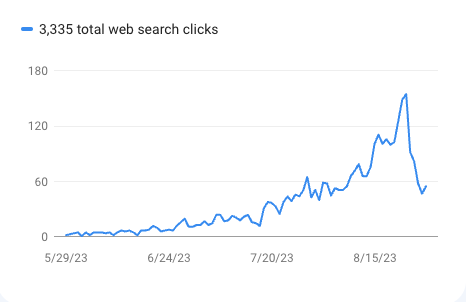Content marketing is crucial for any online business owner looking to build their brand and connect with customers. But it can also seem overwhelming to develop a content strategy from scratch when you’re just starting out (or starting over).
In this guide, I’ll cover almost everything you need to know about crafting an effective content marketing plan, even with a limited budget. You’ll learn about the key channels to focus on, tools to utilize, and strategies to implement so you can start growing your business through quality content.
What is Content Marketing?
Content marketing is a strategic marketing approach focused on creating and distributing valuable, relevant, and consistent content to attract and retain a clearly defined audience. It drives profitable customer action by building trust and relationships through storytelling and useful information rather than overt sales pitches. This article that you’re reading now is a part of my content marketing strategy.
Unlike traditional advertising, content marketing focuses less on selling and more on providing the content your audience is seeking. If you’ll notice, I’m not selling anything in this article. The types of content you can create are nearly endless, including blog posts, videos, podcasts, ebooks, visual graphics, guides, and more. The format matters less than the value you provide.
Two things you should think about when you think about format. First, you should pick something you like to create (which will ideally also be something you like to consume). If you hate doing it, you’re probably not going to stick with it long enough to get traction. Second, you need to think about what format(s) your ideal customers are likely to want to consume. No sense making content that no one wants to consume. I have a friend that hates to read anything longer than a magazine article. Your book may be the next Anna Karenina, but he’s not going to read it. So think about what format(s) your target audience consumes and choose accordingly. And if you’re trying to reach me, it’s books, audiobooks, podcasts and courses if I’m trying to learn something in depth. YouTube if I’m trying to learn something quick or be entertained. Social media if I want to be entertained.
Why Online Business Owners Should Prioritize Content Marketing
For new (or newish) business owners creating their brand online, content marketing should be a top priority from the start. Here are some of the key reasons why:
- High ROI potential: Content marketing costs 62% less than outbound marketing but generates more than 3 times the leads. Quality content remains online forever, compounding your results over time. And while this is true, you have to be consistent and persistent (in it for the long run) if you want to see the highest returns.
- Increased brand awareness: Consistent, valuable content helps establish domain authority and improves search engine rankings so you can get discovered by your ideal customers.
- Audience engagement: People consume content to satisfy needs and curiosity. Your content fills those gaps while building relationships.
- Customer loyalty: When you provide consistent value, customers are more likely to trust you and become brand advocates.
The Channels That Matter
While you can utilize many channels for your content, it’s best to focus your limited time on the ones that deliver results. Here are some of the best channels for new business owners to prioritize:
Blogs
Depending on your audience, a company blog should probably be the foundation of your content marketing. Yes, even in the age of TikTok or whatever social media is hot right now. Blog posts are an effective way to establish expertise and authority. Here’s how to succeed with blogging:
- Pick your platform: Self-hosted WordPress sites offer the most customization while managed options like Medium provide simplicity. I use a self-hosted WordPress site because I can control it more than I can a place like Medium or Substack. I’m not against those places, I just like having my own place.
- Create valuable posts: Write educational articles that address pain points for your readers. Include tips, how-tos, roundups, and other useful content. If you’re wondering what your readers’ pain points are, you should probably check out my Ultimate Guide to Creating A Customer Avatar.
- Optimize for SEO: Use target keywords, meta descriptions, alt text, and internal linking to boost organic search visibility. Check out Yoast SEO or SEMrush for optimization tools. If you want to know more about SEO, what it is and why you should care, you can check out my article about SEO here.
- Promote your posts: Share your blog content on social media, email newsletters, and elsewhere to amplify its reach. If you want a list of places to promote your posts, check out my list here.
Social Media
With billions of active users, social platforms present big opportunities to connect with your audience by sharing your content.
- Facebook: Great for consumer brands. Use video, images and text to educate and engage.
- Instagram: Ideal for visual content and engagement with a younger demographic.
- Twitter: Share quick thoughts, relevant articles, and engage with your industry.
- YouTube: Video content helps boost authority and rankings. Short how-tos and testimonials work well.
- TikTok: Short form video content. At first it was all young people. These days but I see more and more adults on there. If your audience is there, you should consider being there, too.
Always remember, though, that you don’t own the social media platforms, and you can get kicked off for seemingly trifling reasons. I have a friend who hired a Facebook marketing guru to help her grow her audience on Facebook. Facebook didn’t like something that the guru told her to do… BAM! Lifetime ban from advertising on Facebook. No more business growth on Facebook.
Email Marketing
Email subscribers provide a captive audience to consume your content. Use emails to share blog posts, guides, news and more.
- Build your list: Offer lead magnets like free resources in exchange for emails. I recommend offering valuable free stuff more than offering a discount unless you’re selling a physical product. Integrate email signup forms on your site.
- Deliver value: Send a regular cadence of emails with truly useful content that nurtures relationships. Avoid over-promotional messaging. Notice where I said, “truly useful?” Also, for the record, “regular cadence” means frequently. Blue moons come at a regular cadence of every 2.7 years or so, but that’s not good enough if you’re trying to build a business. I recommend more often than monthly, so weekly or more often. The key here is to make your emails impressive. Anything else and your audience won’t want to open them. You can never send too many truly valuable emails, but even one boring email is one too many.
- Autoresponder: Aweber, Mailchimp and ConvertKit (plus approximately a million more) are platforms make it easy to create opt-in forms, automate emails, and track results. Many have free tiers to get started.
Crafting Your Content Strategy
Creating a documented content strategy will help focus your efforts for maximum impact. Outline the following:
- Goals: What business goals will your content support? (ex. increase brand awareness, generate leads, etc.)
- Target audience: Who are you creating content for? Detail their challenges, interests, and position in the buyer’s journey.
- Topic pillars: What topics and themes align to your products/services and audience interests? Consider seasonality too.
- Content calendar: Map out the specific types of content you’ll develop month-by-month across channels.
Budget Considerations
You don’t need a huge budget to implement effective content marketing as a new business. Here are some budget tips:
- Many platforms offer free tiers or discounted rates for new accounts, including Mailchimp, Canva, and Semrush.
- Produce some DIY content using your own skills before outsourcing.
- Re-purpose content into multiple formats to improve ROI. Turn a blog post into a video or podcast.
- Set a modest monthly budget for any paid tools or freelancers. Allocate budget increases as your business grows.
Outsourcing and Tools
As your strategy matures, consider outsourcing to freelancers and utilizing automation tools for greater efficiency.
- Outsource writers: Affordable writers at Upwork or Fiverr can help create more content.
- Automation tools: Schedule social media posts with Buffer or Hootsuite. Use Zapier to integrate your apps and automate workflows.
- Email marketing: Many email platforms like ConvertKit allow you to schedule and automate broadcast emails.
The Role of AI in Content Creation
Advancements in AI now allow business owners to automate some content creation tasks to improve efficiency. You can use AI for:
- Keyword research: Tools like SEMrush or Frase help generate targeted keywords using AI.
- AI writing assistants: Services like ShortlyAI or Conversion.ai can create blog drafts for you to edit.
- Graphic creation: Canva uses AI to improve image and design recommendations.
However, take care not to over-rely on AI. Original, human-written content tends to perform best for establishing trust and expertise. Use AI as a supplement to your own skills. And if you put yourself in the content, search engines will find out and stop sending you as much traffic. Someone I follow on social media built her website on AI generated content with little of her own thoughts/ideas/perspectives (according to her), and this is what happened to her website traffic when Google updated how they assess websites:

Real-World Examples
Let’s look at a few examples of effective content marketing strategies:
Example 1: A blog-centric strategy
Marketing agency Single Grain built its content marketing strategy around educational blogging. With over 500 posts on topics like “The Beginner’s Guide to Customer Lifetime Value” and “How to Drive Traffic to Your Website”, they established domain authority in marketing. The blog content also generated over 50,000 email subscribers.
Example 2: A social media-driven campaign
When launching their line of gourmet condiments, Mike’s Hot Honey focused primarily on Instagram and TikTok. They cemented their brand identity through viral videos of people reacting to trying the spicy honey. The social content expanded their reach and boosted sales.
Example 3: An email marketing success story
Within their first year, personalized shopping service Trunk Club grew their email list to over 100,000 highly-engaged subscribers. By consistently providing value like style tips and wardrobe advice, they built loyalty leading to over $100 million in revenue.
How to Measure Success
It’s important to track key metrics to understand what content resonates with your audience and generates results. Here are a few top options:
- Google Analytics: Provides data on site traffic sources, audience location, pages visited, referral links clicked and more.
- Social media insights: Each platform offers analytics into your followers, engagement, clicks, and more.
- Email metrics: Your email platform should track open rates, clicks, unsubscribes, and engagement by email type.
- A/B testing: Try different headlines, calls to action, or content formats to see which perform best.
Start Your Content Marketing Journey
Developing a strategic content marketing plan is crucial for any new online business owner looking to build awareness and trust with their audience in a cost-effective way.
While it may seem intimidating at first, start small by creating value content focused on your audience’s needs and interests. Dedicate time consistently, track your results, and evolve your strategy. With the right focus on value-driven content creation and distribution, you can build an audience that sustains long-term business growth.
Let me know if you have any other questions! I’m happy to help you develop your successful content marketing strategy.

Leave a Reply